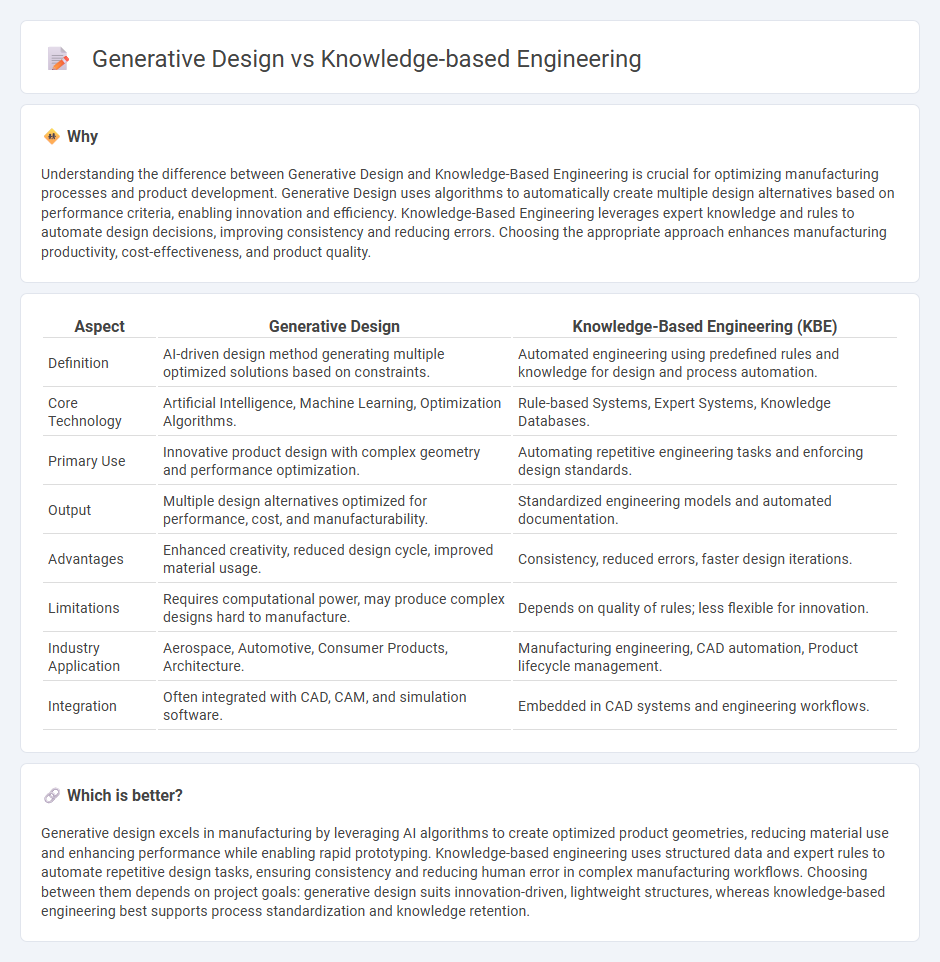
Generative design leverages AI algorithms to create numerous design alternatives by exploring complex geometries and optimizing for performance, weight, and cost. Knowledge-based engineering relies on capturing expert knowledge and engineering rules to automate repetitive design tasks and ensure compliance with standards. Discover how these advanced methodologies transform manufacturing efficiency and innovation.
Why it is important
Understanding the difference between Generative Design and Knowledge-Based Engineering is crucial for optimizing manufacturing processes and product development. Generative Design uses algorithms to automatically create multiple design alternatives based on performance criteria, enabling innovation and efficiency. Knowledge-Based Engineering leverages expert knowledge and rules to automate design decisions, improving consistency and reducing errors. Choosing the appropriate approach enhances manufacturing productivity, cost-effectiveness, and product quality.
Comparison Table
| Aspect | Generative Design | Knowledge-Based Engineering (KBE) |
|---|---|---|
| Definition | AI-driven design method generating multiple optimized solutions based on constraints. | Automated engineering using predefined rules and knowledge for design and process automation. |
| Core Technology | Artificial Intelligence, Machine Learning, Optimization Algorithms. | Rule-based Systems, Expert Systems, Knowledge Databases. |
| Primary Use | Innovative product design with complex geometry and performance optimization. | Automating repetitive engineering tasks and enforcing design standards. |
| Output | Multiple design alternatives optimized for performance, cost, and manufacturability. | Standardized engineering models and automated documentation. |
| Advantages | Enhanced creativity, reduced design cycle, improved material usage. | Consistency, reduced errors, faster design iterations. |
| Limitations | Requires computational power, may produce complex designs hard to manufacture. | Depends on quality of rules; less flexible for innovation. |
| Industry Application | Aerospace, Automotive, Consumer Products, Architecture. | Manufacturing engineering, CAD automation, Product lifecycle management. |
| Integration | Often integrated with CAD, CAM, and simulation software. | Embedded in CAD systems and engineering workflows. |
Which is better?
Generative design excels in manufacturing by leveraging AI algorithms to create optimized product geometries, reducing material use and enhancing performance while enabling rapid prototyping. Knowledge-based engineering uses structured data and expert rules to automate repetitive design tasks, ensuring consistency and reducing human error in complex manufacturing workflows. Choosing between them depends on project goals: generative design suits innovation-driven, lightweight structures, whereas knowledge-based engineering best supports process standardization and knowledge retention.
Connection
Generative design leverages algorithms to create optimized manufacturing solutions by exploring vast design possibilities based on specified constraints. Knowledge-based engineering integrates expert knowledge and design rules, enabling automated decision-making throughout the product development process. The synergy between generative design and knowledge-based engineering accelerates innovation and improves efficiency by combining data-driven creativity with structured expertise in manufacturing workflows.
Key Terms
Rule-based automation
Rule-based automation in knowledge-based engineering (KBE) utilizes predefined rules to capture expert knowledge for repetitive engineering tasks, ensuring consistency and reducing errors. Generative design, contrastingly, employs algorithms to explore multiple design alternatives based on constraints but often lacks explicit rule-based control, relying more on AI-driven optimization. Discover how integrating rule-based automation can enhance generative design processes and streamline innovation in engineering.
Algorithm-driven optimization
Knowledge-based engineering (KBE) utilizes predefined rules and expert systems to automate design processes, emphasizing structured knowledge integration for efficiency and consistency. Generative design relies on algorithm-driven optimization, employing AI and computational power to explore vast design spaces and generate innovative solutions based on defined objectives and constraints. Explore detailed comparisons to understand how each approach drives innovation in engineering optimization.
Parametric modeling
Knowledge-based engineering leverages predefined rules and historical data to automate parametric modeling, enhancing design accuracy and efficiency. Generative design uses algorithms to explore vast design possibilities within parametric constraints, optimizing for specific performance criteria. Discover how these approaches revolutionize parametric modeling by exploring their unique capabilities and applications.
Source and External Links
Introduction to Knowledge-Based Engineering (KBE) - Knowledge-Based Engineering (KBE) is a computer-based system that uses engineering knowledge to automate and customize product design, improving efficiency by eliminating repetitive work and enabling focus on complex tasks, typically involving a knowledge base and reasoning engine.
Knowledge based Engineering (KBE) - Infosys (PDF) - KBE captures and embeds product and design process knowledge into software systems, allowing engineers to generate specific product designs quickly and cost-effectively by reusing and applying existing product knowledge.
Knowledge-based engineering - Wikipedia - KBE applies knowledge-based systems technology to manufacturing design and production, using formal knowledge models to enhance integration, reuse, maintenance, and automation in engineering tasks beyond traditional CAD methods.
 dowidth.com
dowidth.com